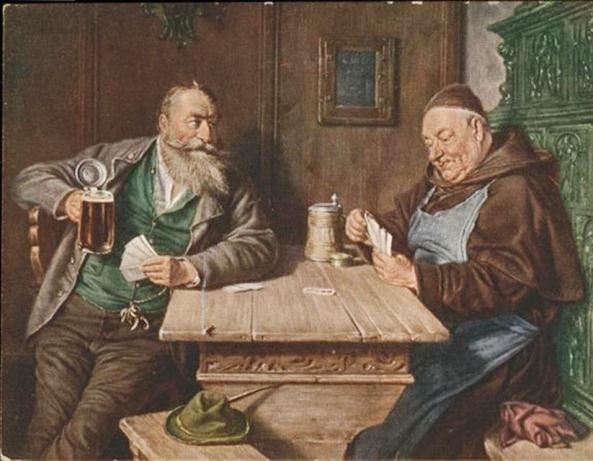
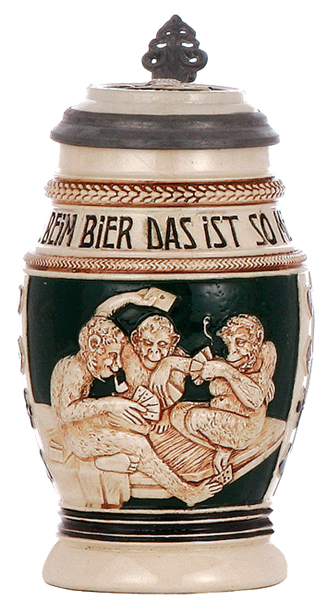
The card playing monkeys, one getting ready to” slap down” a card. In “illegal play pinochle,” this “slap” means [a] the person doing it is now out of the suit just played, and it is a signal to one’s partner to lead that suit next time, so that the person doing the “slapping down” can trump it, or [b] has the rest of the leading cards in that suit. [photo tsaco]
AVERY BRIEF HISTORY OF CARDS: Playing cards first entered Europe in the late 14th century, probably from Mamluk Egypt, with suits very similar to the tarot suits of Swords, Staves, Cups and Coins (also known as disks, and pentacles) and those still used in traditional Italian, Spanish and Portuguese decks. The first documentary evidence is a ban on their use in 1367, Bern, Switzerland. Wide use of playing cards in Europe can, with some certainty, be traced from 1377 onwards. In the late 14th century, the use of playing cards spread rapidly throughout Europe. Documents mentioning cards date from 1371 in Spain, 1377 in Switzerland, and 1380 in many locations including Florence and Paris.[15][16] A 1369 Paris ordinance [on gaming?] does not mention cards, but its 1377 update does. In the account books of Johanna, duchess of Brabant and Wenceslaus I, duke of Luxemburg, an entry dated May 14, 1379, reads: “Given to Monsieur and Madame four peters, two forms, value eight and a half moutons, wherewith to buy a pack of cards”. In his book of accounts for 1392 or 1393, Charles or Charbot Poupart, treasurer of the household of Charles VI of France, records payment for the painting of three sets of cards.[17] The earliest cards were made by hand, like those designed for Charles VI; this was expensive. Printed woodcut decks appeared in the 15th century. The technique of printing woodcuts to decorate fabric was transferred to printing on paper around 1400 in Christian Europe, very shortly after the first recorded manufacture of paper there, while in Islamic Spain it was much older. The earliest dated European woodcut is 1418. No examples of printed cards from before 1423 survive. But from about 1418 to 1450 professional card makers in Ulm, Nuremberg, and Augsburg created printed decks. Playing cards even competed with devotional images as the most common uses for woodcut in this period. Most early woodcuts of all types were coloured after printing, either by hand or, from about 1450 onwards, stencils. These 15th century playing cards were probably painted. The ” Master of the Playing Cards” worked in Germany from the 1430s with the newly invented printmaking technique of engraving. Several other important engravers also made cards, including Master ES and Martin Schongauer. Engraving was much more expensive than woodcut, and engraved cards must have been relatively unusual. In the 15th century in Europe, the suits of playing cards varied; typically a deck had four suits, although five suits were common and other structures are also known. In Germany, hearts (Herz/Rot), bells (Schellen), leaves (Grün), and acorns (Eichel) became the standard suits and are still used in Eastern and Southeastern German decks today for Skat, Schafkopf, Doppelkopf, and other games. Italian and Spanish cards of the 15th century used swords, batons (or wands), cups, and coins (or rings). The Tarot, which included extra trump cards, was invented in Italy in the 15th century. The four suits now used in most of the world — spades, hearts, diamonds, and clubs — originated in France in approximately 1480. The trèfle (club) was probably copied from the acorn and the pique (spade) from the leaf of the German suits. The names “pique” and “spade”, however, may have derived from the sword of the Italian suits. In England, the French suits were eventually used, although the earliest decks had the Italian suits. Also in the 15th century, Europeans changed the court cards to represent European royalty and attendants, originally “king”, “chevalier” (knight), and “knave”. The original meaning of knave was male child, so in this context the character could represent the “prince”, son to the King and Queen; the meaning servant developed later. In a German pack from the 1440s, Queens replace Kings in two of the suits as the highest card. Fifty-six-card decks containing a King, Queen, Knight, and Valet (from the French tarot court) were common. [Excerpted from: http://en.wikipedia.org/wiki/Playing_card#Introduction_into_Europe] 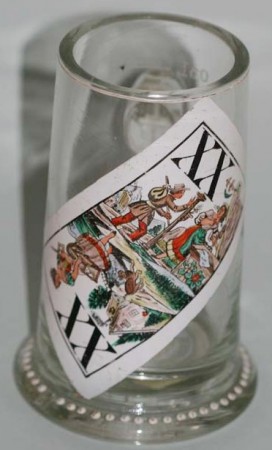 Blown glass .5 liter mug with an enameled Tarot card. Circa 1910. EUROPEAN SUITES: As playing cards became more popular, different cultures created their own suits — as well as their own “royalty” cards, sometimes going as high as six different “face” cards. These decks were hand-painted and included intricate designs of both the suits and the royalty cards. As such, they were expensive to manufacture. In France, Parisian card makers settled on Spades, Hearts, Clubs, and Diamonds as the four suits. The first three of these were adaptations of the German card suits Leaves, Hearts, and Hawk Bells (Acorns was the other German suit). Considering that cards were often made for the French upper class, it isn’t difficult to understand why card makers chose expensive Diamonds over common Acorns. [From: “Cliff’s Notes” = http://www.cliffsnotes.com/Section/Where-do-the-four-suits-in-a-deck-of-cards-originate-What-do-they-represent-.id-305402,articleId-8203.html ]
Blown glass .5 liter mug with an enameled Tarot card. Circa 1910. EUROPEAN SUITES: As playing cards became more popular, different cultures created their own suits — as well as their own “royalty” cards, sometimes going as high as six different “face” cards. These decks were hand-painted and included intricate designs of both the suits and the royalty cards. As such, they were expensive to manufacture. In France, Parisian card makers settled on Spades, Hearts, Clubs, and Diamonds as the four suits. The first three of these were adaptations of the German card suits Leaves, Hearts, and Hawk Bells (Acorns was the other German suit). Considering that cards were often made for the French upper class, it isn’t difficult to understand why card makers chose expensive Diamonds over common Acorns. [From: “Cliff’s Notes” = http://www.cliffsnotes.com/Section/Where-do-the-four-suits-in-a-deck-of-cards-originate-What-do-they-represent-.id-305402,articleId-8203.html ] 
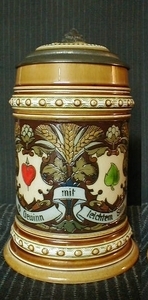 [L] The “French Suits” on a V& B Mettlach. [R] The Old German suits, a very nice pair when together. .
[L] The “French Suits” on a V& B Mettlach. [R] The Old German suits, a very nice pair when together. . 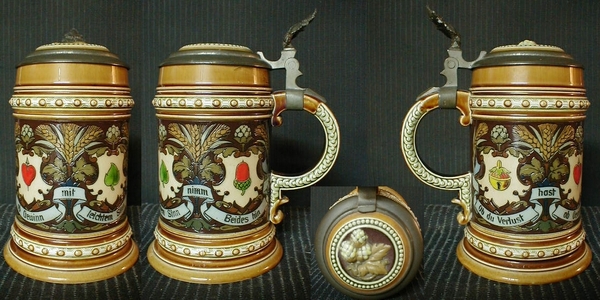 Shown above: The “Old German” suits of cards.[tsaco] Playing cards first entered Europe in the late 14th century, probably from Mamluk Egypt, with suits (sets of cards with matching designs) very similar to the tarot suits of Swords, Staves, Cups and Coins (also known as disks or pentacles), and which are sti
Shown above: The “Old German” suits of cards.[tsaco] Playing cards first entered Europe in the late 14th century, probably from Mamluk Egypt, with suits (sets of cards with matching designs) very similar to the tarot suits of Swords, Staves, Cups and Coins (also known as disks or pentacles), and which are sti
ll used in traditional Italian, Spanish, and Portuguese decks. An old legend . true ???? I kind of doubt it. Common entertainment in the renaissance included playing cards. However, there was a tax levied when purchasing playing cards but only applicable to the “Ace of Spades.” To avoid paying the tax, people would purchase 51 cards instead. Yet, since most games require 52 cards, these people were thought to be stupid or dumb because they weren’t “playing with a full deck.” POTTERY – RELIEF, INCISED, OR PUG (PRINT UNDER GLAZE.) 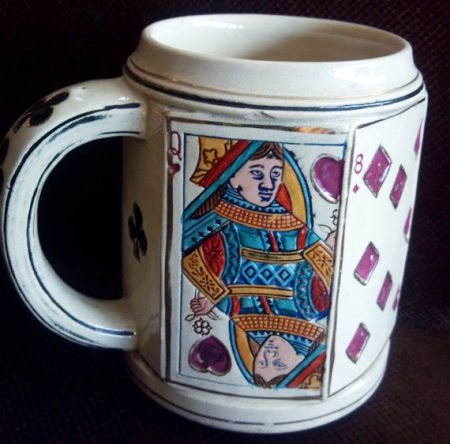
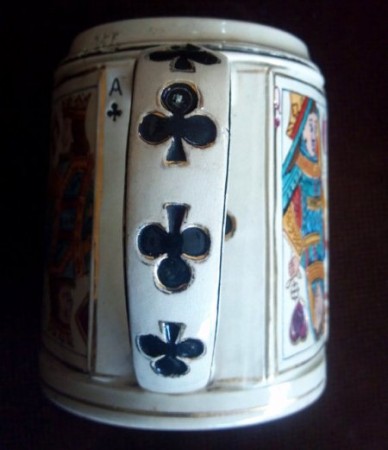 A half liter lidless stein while this looks brand new, it is Marked “Germany” #1427.
A half liter lidless stein while this looks brand new, it is Marked “Germany” #1427. 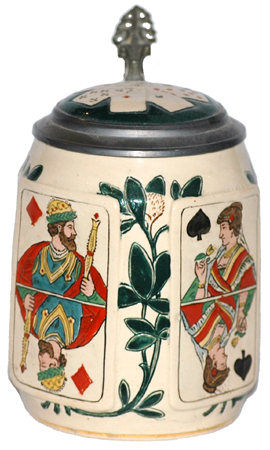 .
. 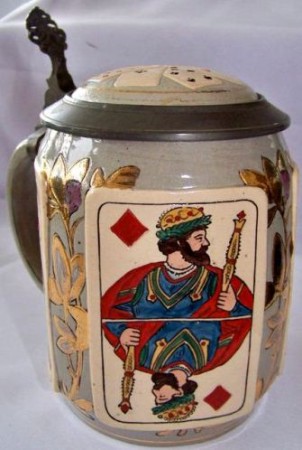
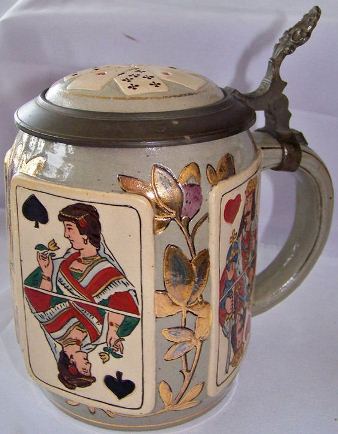 Different stein décor with the flowers between the cards Obviously a variant by the same maker. The lid design on both.
Different stein décor with the flowers between the cards Obviously a variant by the same maker. The lid design on both. 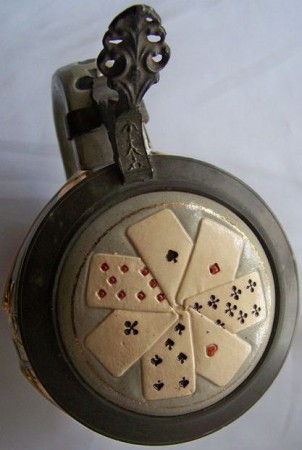
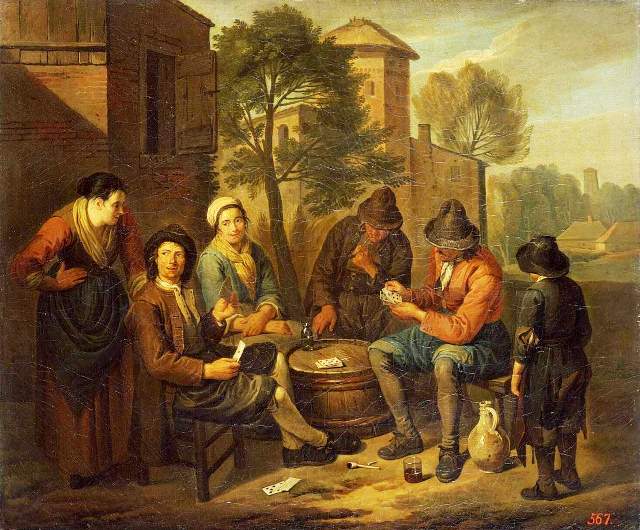 Peasants at cards. [WEB GALLERY OF ART]
Peasants at cards. [WEB GALLERY OF ART] 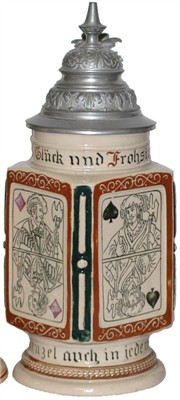
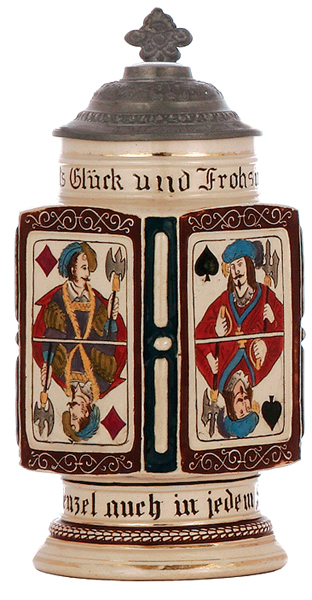 Two versions of an incised pottery stein, .5L, marked 686. Four Jacks. [tsaco]
Two versions of an incised pottery stein, .5L, marked 686. Four Jacks. [tsaco] 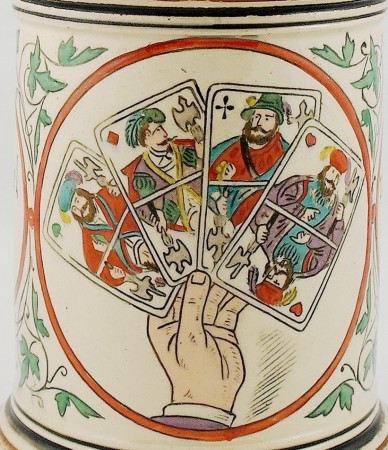 The exact same four Jacks it appears. Same stein designer, or the most common available deck of cards when stein was made? Or both?
The exact same four Jacks it appears. Same stein designer, or the most common available deck of cards when stein was made? Or both? 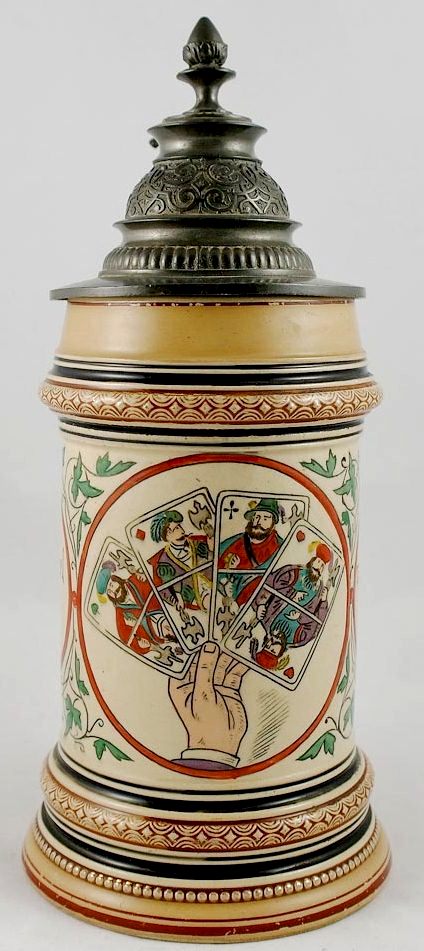 Manufaktur: Reinhold Merkelbach, Grenzhausen. Ca.1910. Form #928. Height: 21,5 cm.
Manufaktur: Reinhold Merkelbach, Grenzhausen. Ca.1910. Form #928. Height: 21,5 cm. ![cards- Pottery Etched 1-2L. French [NOT] suites of cards on four sided body. RFA 11-12](http://www.steveonsteins.com/wp-content/uploads/2011/08/cards-Pottery-Etched-1-2L.-French-NOT-suites-of-cards-on-four-sided-body.-RFA-11-12-299x630.jpg) Yet one more version of squared body showing Tarot cards. A scarce version. [RFA]
Yet one more version of squared body showing Tarot cards. A scarce version. [RFA] 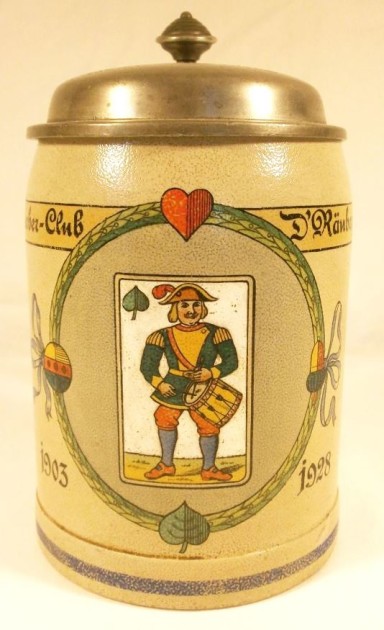 A PUG stoneware .5 liter with Tarot card [comps eBay’s Painterjane]
A PUG stoneware .5 liter with Tarot card [comps eBay’s Painterjane] 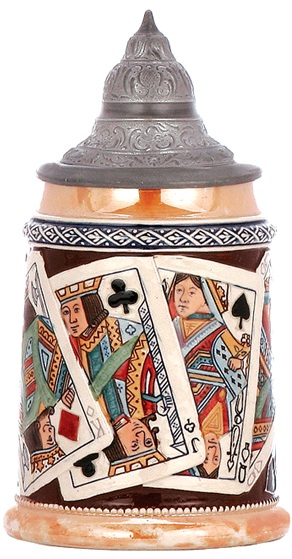 .5 liter pottery with a inexpensive conical pewter lid. Circa 1900. [tsaco]
.5 liter pottery with a inexpensive conical pewter lid. Circa 1900. [tsaco] 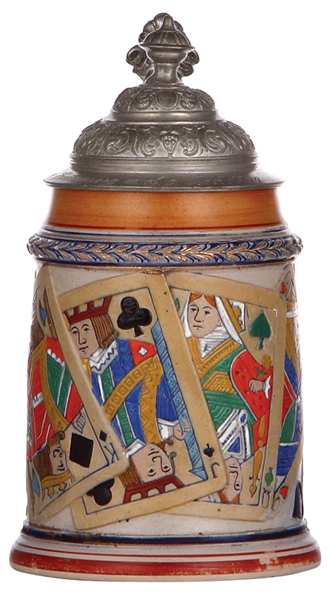 .5 liter with same sequence of cards as just above. [tsaco]
.5 liter with same sequence of cards as just above. [tsaco] 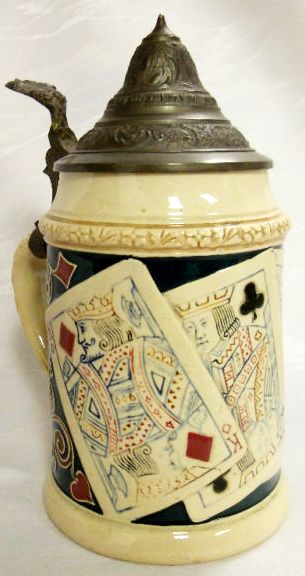
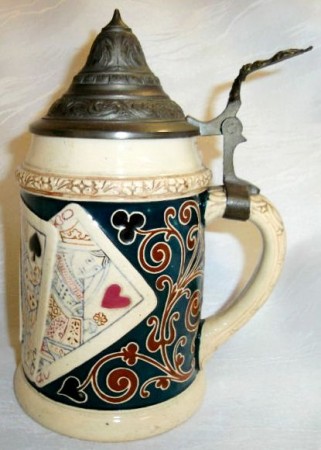 Similar to above, .5 liter. A stock kind of a Card stein.
Similar to above, .5 liter. A stock kind of a Card stein. ![111 CARD HAVE [Q]](http://www.steveonsteins.com/wp-content/uploads/2011/08/111-CARD-HAVE-Q-337x450.jpg) And yet another version with a false bottom.
And yet another version with a false bottom. 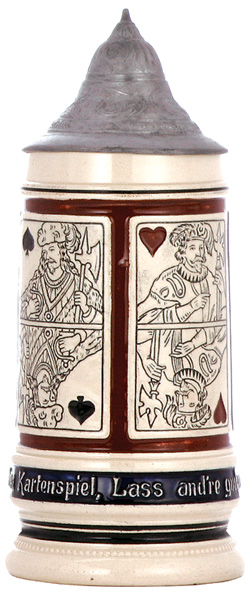
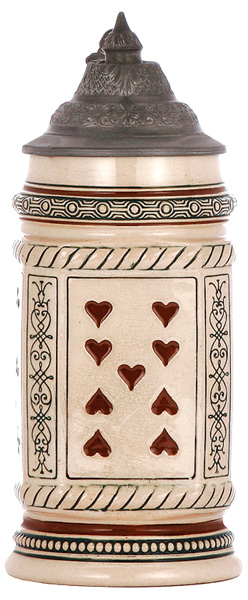 Two nicely done .5 liter incised pottery steins from about 1890.
Two nicely done .5 liter incised pottery steins from about 1890. 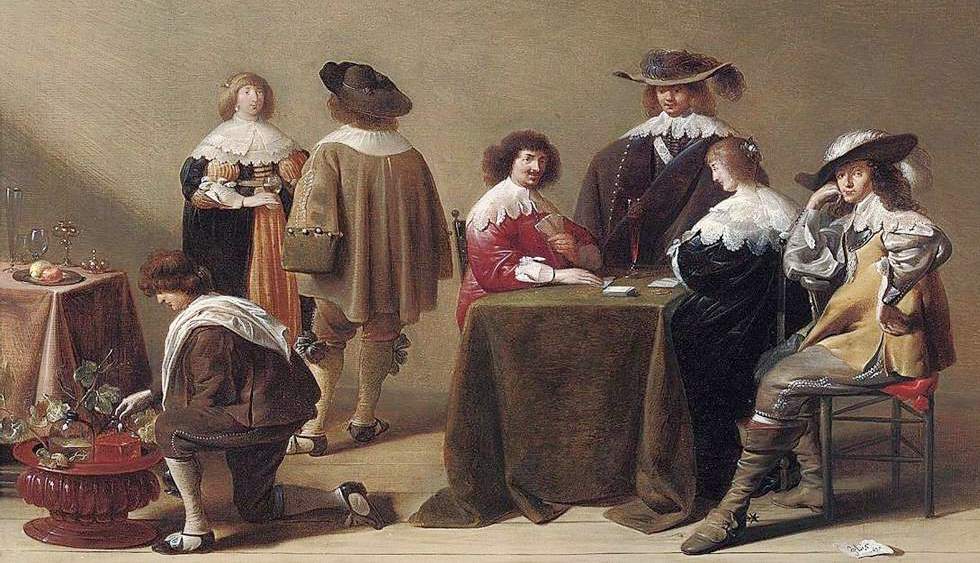 OLIS, Jan Elegant Company Playing Cards.(While drinking from blown glass roemers.) Dated 1637. Oil on panel, 40 x 63 cm, Private collection. [COMPS WEB GALLERY OF ART] For more info on Roemers, please see: http://www.steveonsteins.com/roemers-1-a-brief-account-of-their-history-and-a-small-pictorial-review WOMEN AND CARDS ▼ “Girls today . take up dice, cards and other masculine amusements.” Desiderius Erasmus, Colloquies, 1529 This complaint comes from one of the speakers in Erasmus’s dialogue on ‘Knucklebones, or the game of tali’. He would have easily recognized the sheet of playing cards, printed from a wooden block, with the knave (or jack) of hearts and the knave of diamonds repeated alternately. The figure of the ‘knave’ originally meant ‘a son’ and had no negative connotations at the time. It was only later that it came to mean a rogue. The sheet [BELOW▼] dates to the late 15th century and shows two of the four suit signs that had been adopted by French card-makers by this date, the same spades, hearts, clubs and diamonds that are in use today. The cards are marked with the initials G.S.C. and G. Cartier, which suggest that the artist was Giles Savouré (also known as ‘Cartier’ or ‘Cardmaker’ in French), who worked in Lyons from about 1480 to 1506. This survival of the artist’s name is very unusual as playing cards were ephemeral objects that became bent and dirty through use and were eventually thrown away.
OLIS, Jan Elegant Company Playing Cards.(While drinking from blown glass roemers.) Dated 1637. Oil on panel, 40 x 63 cm, Private collection. [COMPS WEB GALLERY OF ART] For more info on Roemers, please see: http://www.steveonsteins.com/roemers-1-a-brief-account-of-their-history-and-a-small-pictorial-review WOMEN AND CARDS ▼ “Girls today . take up dice, cards and other masculine amusements.” Desiderius Erasmus, Colloquies, 1529 This complaint comes from one of the speakers in Erasmus’s dialogue on ‘Knucklebones, or the game of tali’. He would have easily recognized the sheet of playing cards, printed from a wooden block, with the knave (or jack) of hearts and the knave of diamonds repeated alternately. The figure of the ‘knave’ originally meant ‘a son’ and had no negative connotations at the time. It was only later that it came to mean a rogue. The sheet [BELOW▼] dates to the late 15th century and shows two of the four suit signs that had been adopted by French card-makers by this date, the same spades, hearts, clubs and diamonds that are in use today. The cards are marked with the initials G.S.C. and G. Cartier, which suggest that the artist was Giles Savouré (also known as ‘Cartier’ or ‘Cardmaker’ in French), who worked in Lyons from about 1480 to 1506. This survival of the artist’s name is very unusual as playing cards were ephemeral objects that became bent and dirty through use and were eventually thrown away. 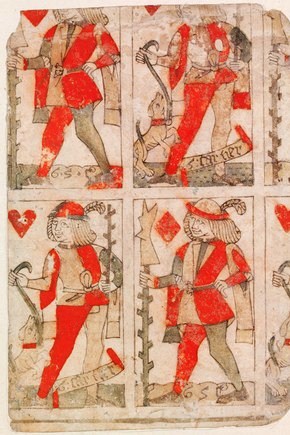 Part of an uncut sheet of woodblock printed playing cards, by Gilles Savoure, Lyon, France, 1490-1500. [V & A Museum] When card games arrived in Europe in the early 14th century, they were at first the preserve of the well-to-do because the cards were hand-painted and subsequently expensive. However, the advent of woodblock printing led to a system of relatively cheap mass production, in which cards could be printed in sheets from a single wood block. As a result, card playing became exceedingly popular with both men and women and at all social levels – so much so that a Paris decree in 1397 forbade people to play at ‘tennis, bowls, dice, cards or ninepins on working days’, while Henry VII of England (reigned 1485–1509) forbade servants and apprentices from playing at cards except at Christmas. Preachers, theologians and moralizers all railed against their use. In Bologna in 1423 the Franciscan friar, and later saint, Bernardino da Siena preached so successfully against gaming that the people threw thousands of cards onto a great bonfire in the public square. Despite these strictures, gambling was still a widespread pastime. Furthermore, playing for fun, rather than for money, was not condemned, so cards themselves did not attract censure. Indeed, when the 15th-century artist Antonio Cicognara painted a set of tarot cards (used for gaming rather than divination) and presented them to Cardinal Sforza, the Bishop of Pavia and Novara, the cardinal evidently felt no moral qualms in asking the artist to make similar packs for his sisters, who were nuns in the Augustinian convent in Cremona. Women were often avid card players. Parisina Malatesta, the young Duchess of Ferrara, ordered an expensive hand-painted pack for herself in 1423, and a year later sent off for two cheaper packs for her little twin daughters, Lucia and Ginevra. That women often gambled with money is also clear. Mary Tudor (1516–58), daughter of Henry VIII of England, and later Mary I of England, ran up substantial debts due to her constant card playing, while the pious archduchess Johanna of Austria seems to have enjoyed better luck in the popular French card game of piquet. FROM: The V & A Museum London England. See: http://www.vam.ac.uk/content/articles/r/renaissance-women-at-leisure/
Part of an uncut sheet of woodblock printed playing cards, by Gilles Savoure, Lyon, France, 1490-1500. [V & A Museum] When card games arrived in Europe in the early 14th century, they were at first the preserve of the well-to-do because the cards were hand-painted and subsequently expensive. However, the advent of woodblock printing led to a system of relatively cheap mass production, in which cards could be printed in sheets from a single wood block. As a result, card playing became exceedingly popular with both men and women and at all social levels – so much so that a Paris decree in 1397 forbade people to play at ‘tennis, bowls, dice, cards or ninepins on working days’, while Henry VII of England (reigned 1485–1509) forbade servants and apprentices from playing at cards except at Christmas. Preachers, theologians and moralizers all railed against their use. In Bologna in 1423 the Franciscan friar, and later saint, Bernardino da Siena preached so successfully against gaming that the people threw thousands of cards onto a great bonfire in the public square. Despite these strictures, gambling was still a widespread pastime. Furthermore, playing for fun, rather than for money, was not condemned, so cards themselves did not attract censure. Indeed, when the 15th-century artist Antonio Cicognara painted a set of tarot cards (used for gaming rather than divination) and presented them to Cardinal Sforza, the Bishop of Pavia and Novara, the cardinal evidently felt no moral qualms in asking the artist to make similar packs for his sisters, who were nuns in the Augustinian convent in Cremona. Women were often avid card players. Parisina Malatesta, the young Duchess of Ferrara, ordered an expensive hand-painted pack for herself in 1423, and a year later sent off for two cheaper packs for her little twin daughters, Lucia and Ginevra. That women often gambled with money is also clear. Mary Tudor (1516–58), daughter of Henry VIII of England, and later Mary I of England, ran up substantial debts due to her constant card playing, while the pious archduchess Johanna of Austria seems to have enjoyed better luck in the popular French card game of piquet. FROM: The V & A Museum London England. See: http://www.vam.ac.uk/content/articles/r/renaissance-women-at-leisure/ 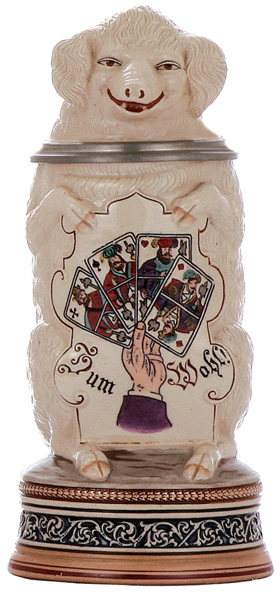 And to give this page a “little character” we have a .5 liter pottery pig. Stamped #1116. No maker’s mark. Same four Jacks as on 9 above. The pig is for “good luck”; see “Kegels” page this site , for further.
And to give this page a “little character” we have a .5 liter pottery pig. Stamped #1116. No maker’s mark. Same four Jacks as on 9 above. The pig is for “good luck”; see “Kegels” page this site , for further.
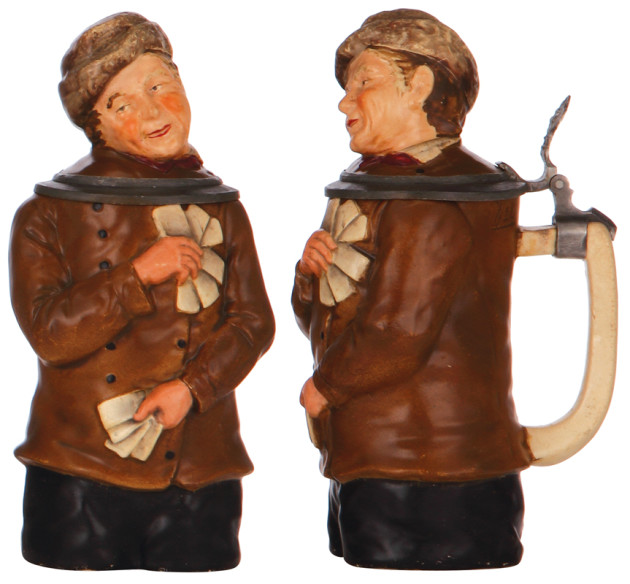 Character steins of card players are scares. Here ▲ is a very sought after and expensive one. [tsaco]
Character steins of card players are scares. Here ▲ is a very sought after and expensive one. [tsaco] 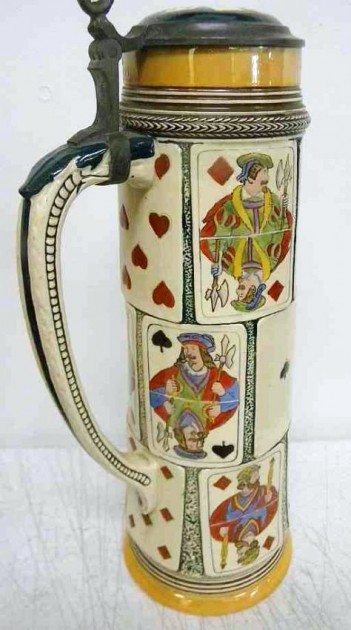
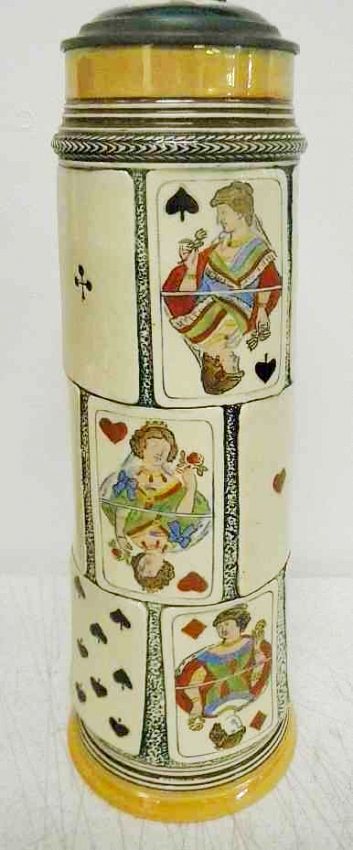
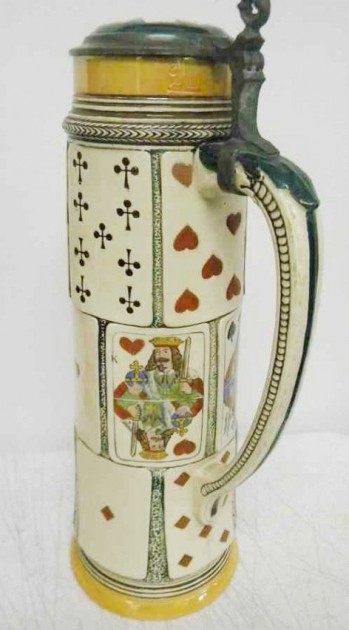
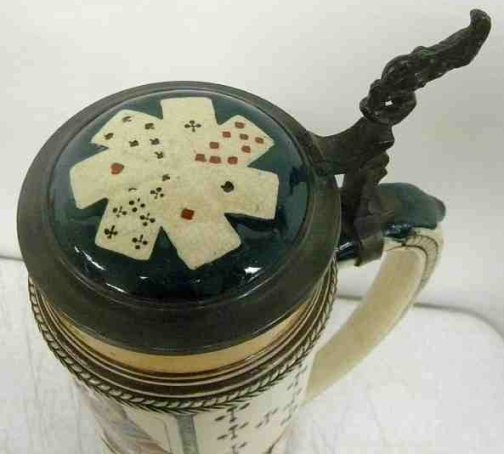 Pretty impressive. I think I’d like to have one of these = 2 liters!
Pretty impressive. I think I’d like to have one of these = 2 liters! 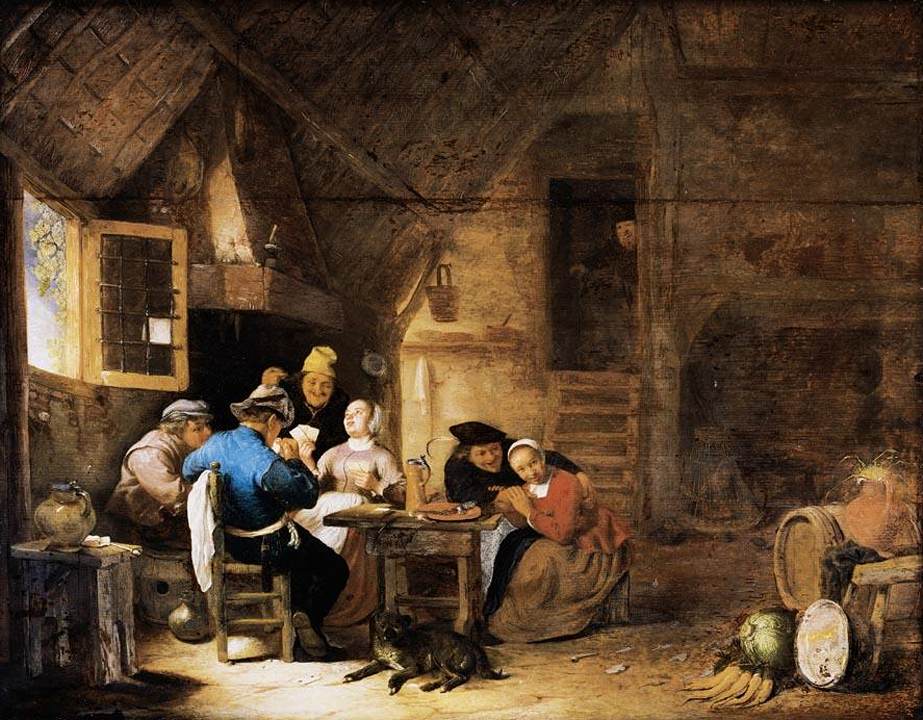 ** SORGH, Hendrick Maertensz. “Interior with Peasants Playing Cards” Oil on panel, 53 x 68 cm Private collection — [WEB GALLEY OF ART] It must be “Rummy.” – I think it’s way to cold (and the window is open) to play strip poker way back then! And Madam X is pictured at the door – very common . SOME CARD STEINS ARE MADE FOR AND MENTION THE THE GAME OF “SKAT”:
** SORGH, Hendrick Maertensz. “Interior with Peasants Playing Cards” Oil on panel, 53 x 68 cm Private collection — [WEB GALLEY OF ART] It must be “Rummy.” – I think it’s way to cold (and the window is open) to play strip poker way back then! And Madam X is pictured at the door – very common . SOME CARD STEINS ARE MADE FOR AND MENTION THE THE GAME OF “SKAT”:  .5 liter molded relief by Dummler and Brieden. Ca. 1890- 1900. . “Skat” was originally played with German suited cards, and these are still in general use in South and East Germany. Elsewhere, “Skat” is played with French suited cards. 32 cards are used: A K Q J 10 9 8 7 in each suit. In the article referenced below, French suits are assumed, but in case you are using German suited cards, the correspondence is as follows: Abbreviation French Suits German Suits club clubs (Kreuz) acorns (Eichel) spade spades (Pik) leaves (Grün) heart hearts (Herz) hearts (Rot) diamond diamonds (Karo) bells (Schellen) K king (König) king (König) Q queen (Dame) ober (Ober) J jack (Bube) unter (Unter) Ranking of Cards = The ranking of the cards depends on the game the declarer chooses to play. For more information on the play rules, see: http://www.pagat.com/schafk/skat.html#cards
.5 liter molded relief by Dummler and Brieden. Ca. 1890- 1900. . “Skat” was originally played with German suited cards, and these are still in general use in South and East Germany. Elsewhere, “Skat” is played with French suited cards. 32 cards are used: A K Q J 10 9 8 7 in each suit. In the article referenced below, French suits are assumed, but in case you are using German suited cards, the correspondence is as follows: Abbreviation French Suits German Suits club clubs (Kreuz) acorns (Eichel) spade spades (Pik) leaves (Grün) heart hearts (Herz) hearts (Rot) diamond diamonds (Karo) bells (Schellen) K king (König) king (König) Q queen (Dame) ober (Ober) J jack (Bube) unter (Unter) Ranking of Cards = The ranking of the cards depends on the game the declarer chooses to play. For more information on the play rules, see: http://www.pagat.com/schafk/skat.html#cards 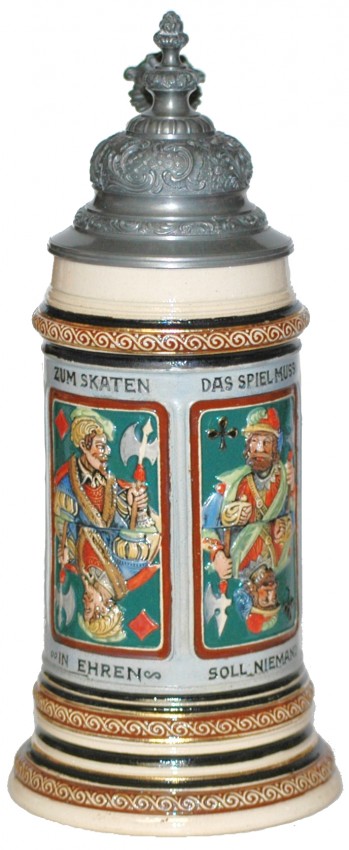 Same body as just above, but with color, an added false bottom and much nicer pewter lid. .
Same body as just above, but with color, an added false bottom and much nicer pewter lid. . 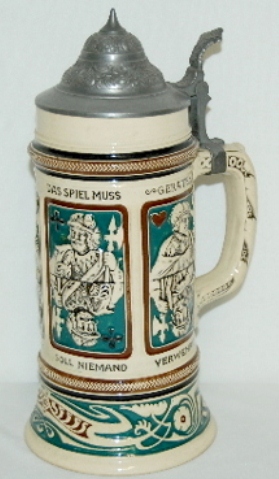 Another variant by the same maker.
Another variant by the same maker. 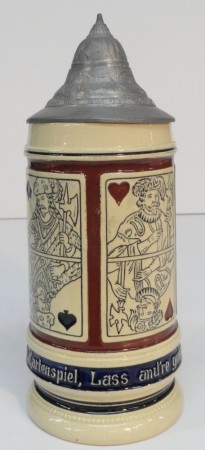
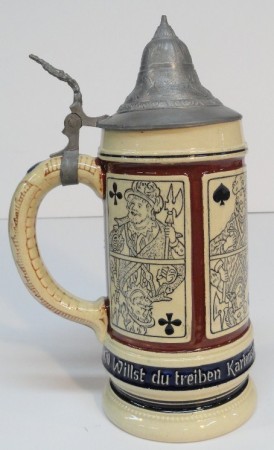 .
. 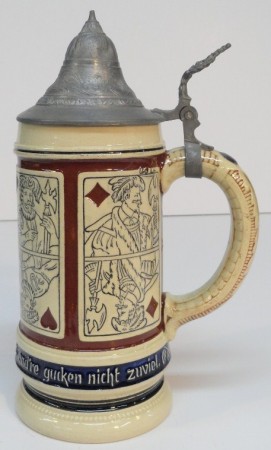
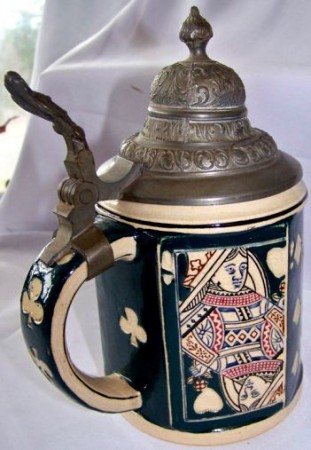
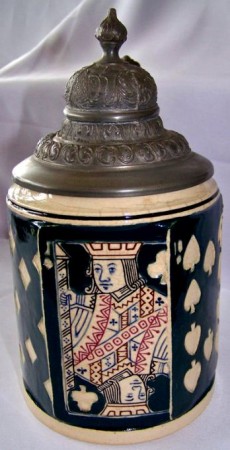 .
. 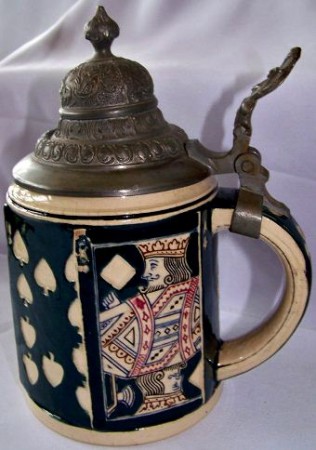 Nicely patterned. .5 liter pottery. Ca. 1890.
Nicely patterned. .5 liter pottery. Ca. 1890. 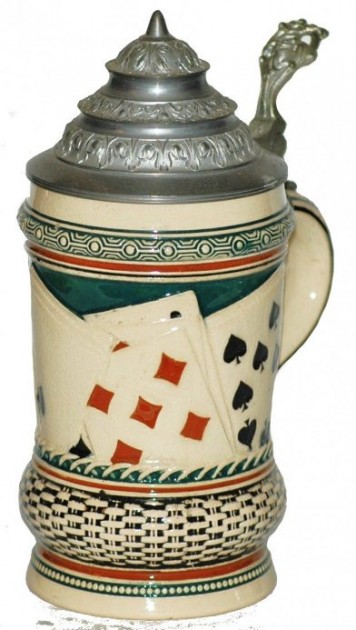 An interesting variant showing no printed numbers on the cards, only the suits [RFA] John: “How should I have played that hand?” Dennis: “Under an assumed name!
An interesting variant showing no printed numbers on the cards, only the suits [RFA] John: “How should I have played that hand?” Dennis: “Under an assumed name! 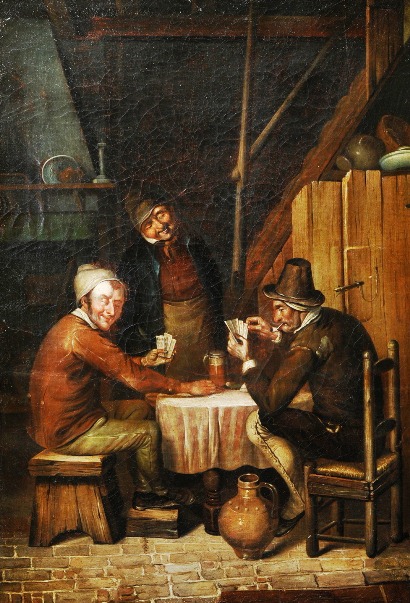 STONEWARE – WESTERWALDS
STONEWARE – WESTERWALDS 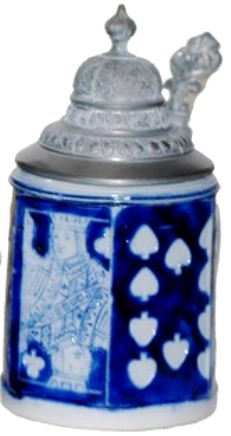 As just above but in stoneware, and with the same lid! PORCELAIN STEINS:
As just above but in stoneware, and with the same lid! PORCELAIN STEINS: 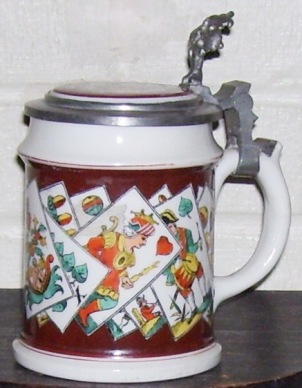 Porcelain – .5 liter – Circa 1870. A nice looking piece. [FWTD]
Porcelain – .5 liter – Circa 1870. A nice looking piece. [FWTD] 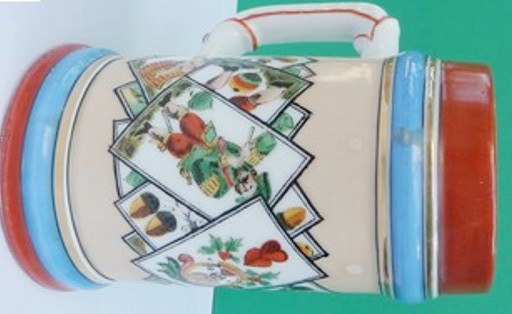
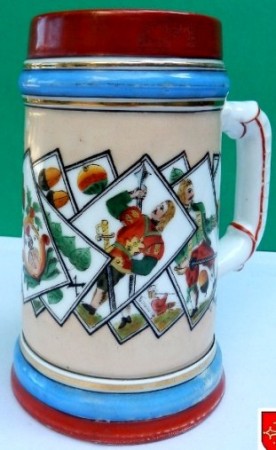
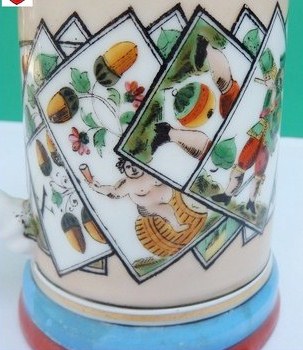
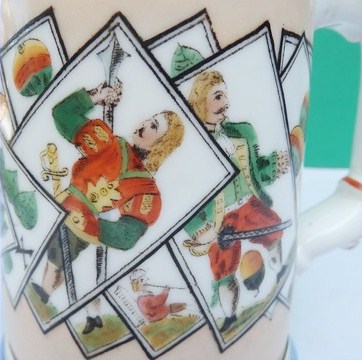 Another porcelain piece from the same time period. These are Tarot Cards. Very distinctive.
Another porcelain piece from the same time period. These are Tarot Cards. Very distinctive. 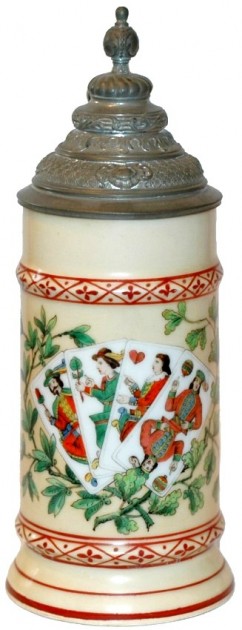 Porcelain. .5 liter with false bottom. Tarot’s. Circa 1890. [RFA]
Porcelain. .5 liter with false bottom. Tarot’s. Circa 1890. [RFA] 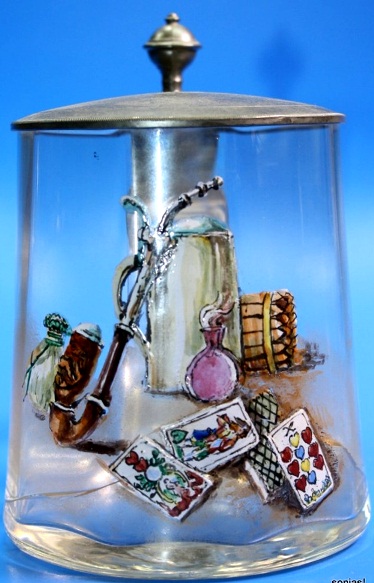 5 liter blown glass with card playing and relaxing paraphernalia. Circa 1900.
5 liter blown glass with card playing and relaxing paraphernalia. Circa 1900. 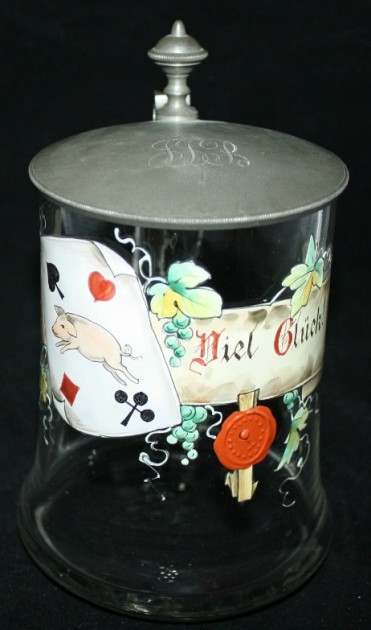 A “Red Seal” card stein By Theresienthal, I believe. See “Red Seal” in this site’s Compendium. The pig is for “good luck”; see Kegels page this site , for further. .
A “Red Seal” card stein By Theresienthal, I believe. See “Red Seal” in this site’s Compendium. The pig is for “good luck”; see Kegels page this site , for further. . 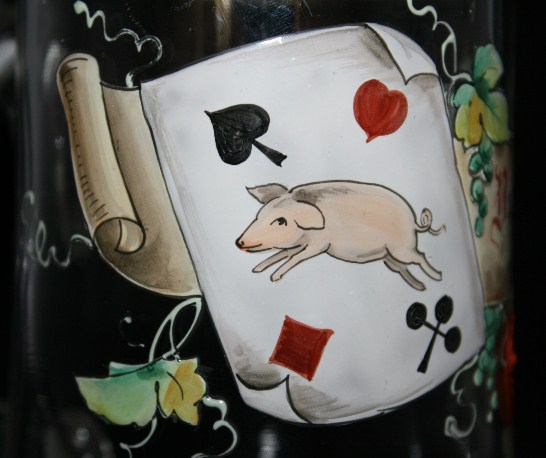 Detail – It appears to be hand painted, but is not. The pig is for good luck !!
Detail – It appears to be hand painted, but is not. The pig is for good luck !! 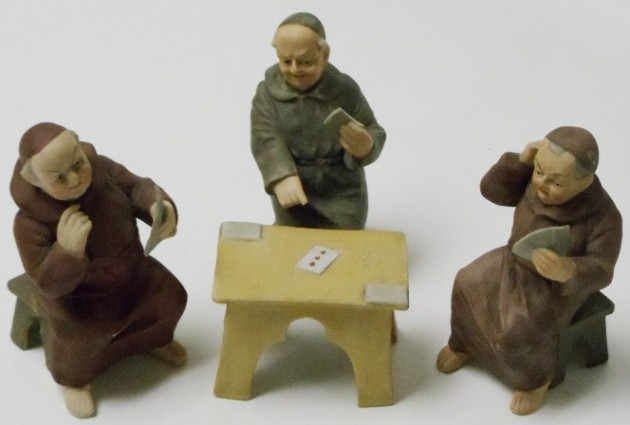 A nice little antique “go with” set, done in bisquit. John: “My steinologist says I can’t play pinochle anymore!” Judy: “You mean your cardiologist, for your health?“ John: “No, it was Steve, he has played with me enough to know I won’t ever get any better!” OTHER V & B, METTLACH CARD STEINS:
A nice little antique “go with” set, done in bisquit. John: “My steinologist says I can’t play pinochle anymore!” Judy: “You mean your cardiologist, for your health?“ John: “No, it was Steve, he has played with me enough to know I won’t ever get any better!” OTHER V & B, METTLACH CARD STEINS: 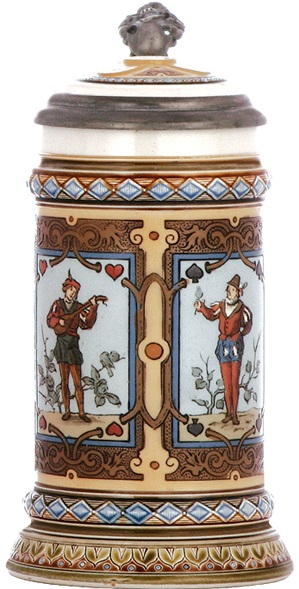 V & B, M, No. 1797
V & B, M, No. 1797 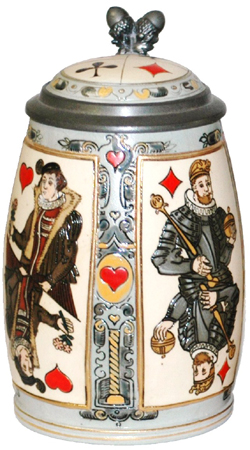 V & B Mettlach card stein, 2093 I think this is one of the best designed steins V &B, M ever made, cards or not. [RFA] Julia to Steve, (on a bad night playing pinochle): “Every day you play worse and worse, but today you are playing like tomorrow!” BEAKERS
V & B Mettlach card stein, 2093 I think this is one of the best designed steins V &B, M ever made, cards or not. [RFA] Julia to Steve, (on a bad night playing pinochle): “Every day you play worse and worse, but today you are playing like tomorrow!” BEAKERS 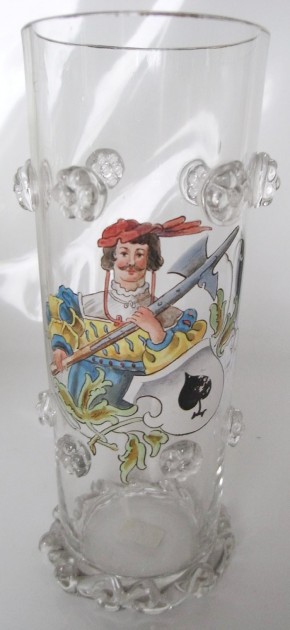
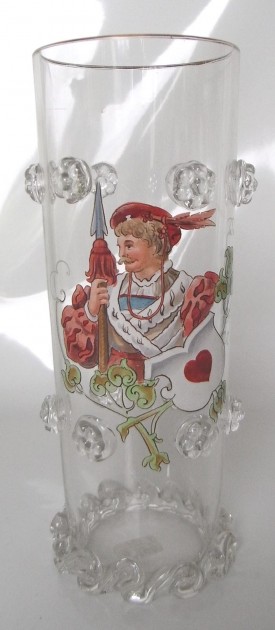 Two “card playing” clear blown enameled glass beakers by Theresienthal. Ca. 1900.
Two “card playing” clear blown enameled glass beakers by Theresienthal. Ca. 1900. 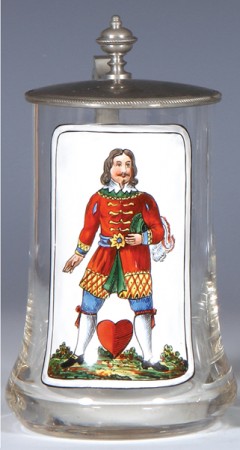 A stein, but along the same line, as just above, an olden Jack of Hearts (Tarot?) on a blown clear glass stein. .5 liter. Ca 1900. Theresienthal?
A stein, but along the same line, as just above, an olden Jack of Hearts (Tarot?) on a blown clear glass stein. .5 liter. Ca 1900. Theresienthal? 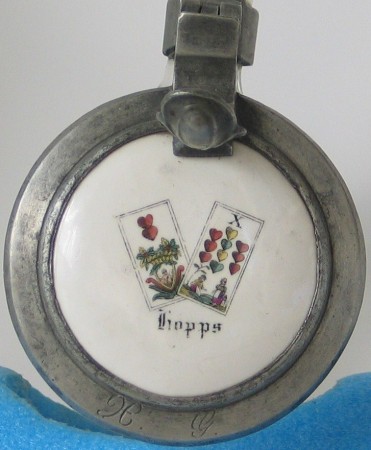
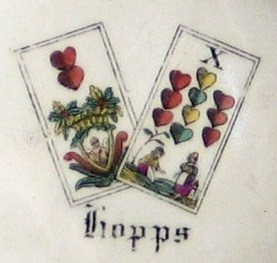 Lid from a colorless plain glass stein, Ca. 1870 – Just to be used for what it was made for = drinking beer!
Lid from a colorless plain glass stein, Ca. 1870 – Just to be used for what it was made for = drinking beer! 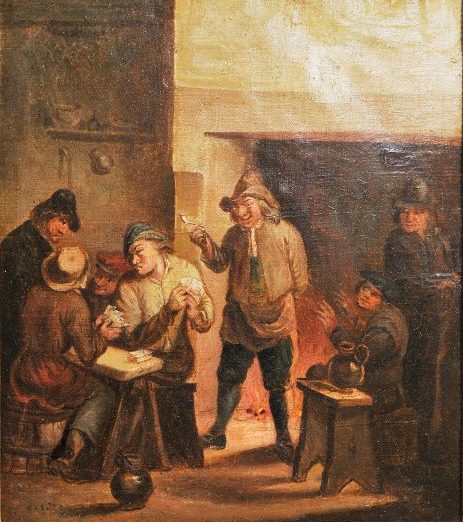 MISCELLANEOUS CARD SCENES:
MISCELLANEOUS CARD SCENES: Not a card stein, but a “Playing Cards” stein. This type of ‘playing’ scene is fairly hard to find. Shown above: A .5 liter, unlidded V & B Mettlach, No. 3253.
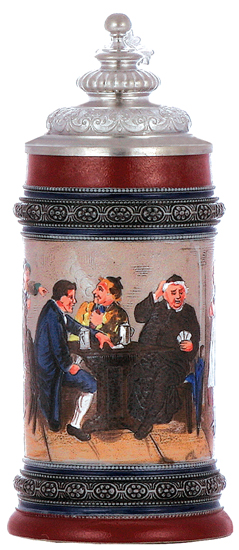 Shown: A lidded .5 litter incised pottery stein by H-R. No164. Circa 1890.
Shown: A lidded .5 litter incised pottery stein by H-R. No164. Circa 1890. 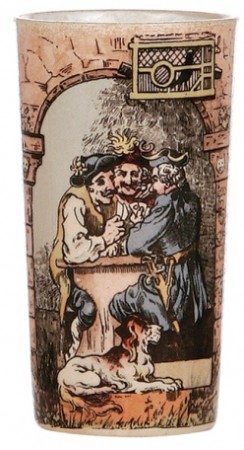 Again not a stein, but a beer beaker, PUG, V& B Mettlach No. 1140 (2327).
Again not a stein, but a beer beaker, PUG, V& B Mettlach No. 1140 (2327). 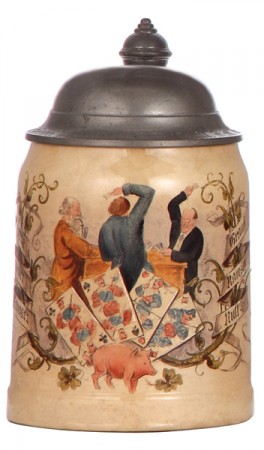 V & B Mettlach stein, .5L, 1526, hand painted, card playing, pewter lid. The pig is for good luck! &
V & B Mettlach stein, .5L, 1526, hand painted, card playing, pewter lid. The pig is for good luck! &
gt; NEWER CARD STEINS = 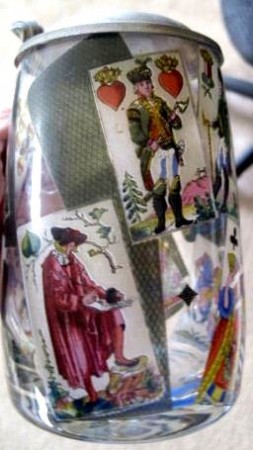
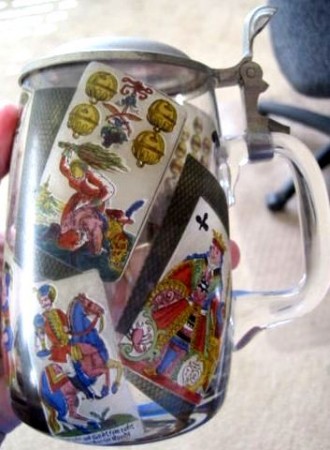 Circa 1990 -2010. Decal (print) on a glass stein, mostly Tarot cards.
Circa 1990 -2010. Decal (print) on a glass stein, mostly Tarot cards. 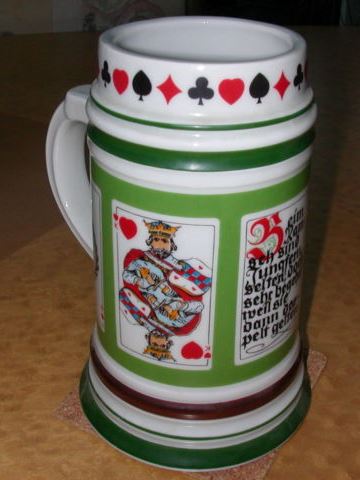 A newer porcelain .5 liter porcelain beer mug. I think it could be a best seller if it had a nice lid on it.
A newer porcelain .5 liter porcelain beer mug. I think it could be a best seller if it had a nice lid on it. 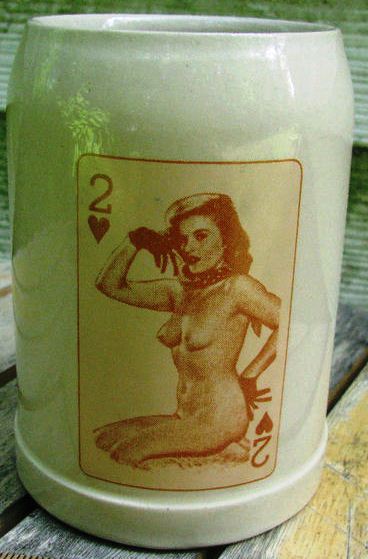 And there is always someone trying to make a “Duetch Mark” or two by selling a little “T & A!” (Very little “T” in this case.
And there is always someone trying to make a “Duetch Mark” or two by selling a little “T & A!” (Very little “T” in this case. 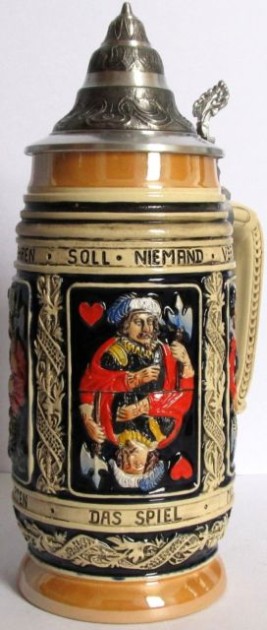 One of the newer steins with cards in relief . 10 inch , .5 liter pottery with nice paint job. Circa 1970- 90.
One of the newer steins with cards in relief . 10 inch , .5 liter pottery with nice paint job. Circa 1970- 90. 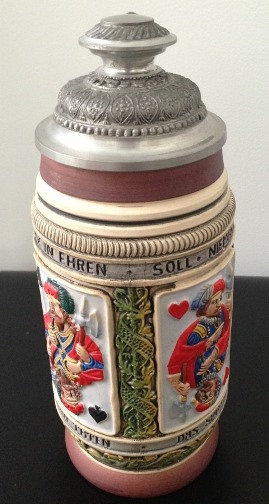
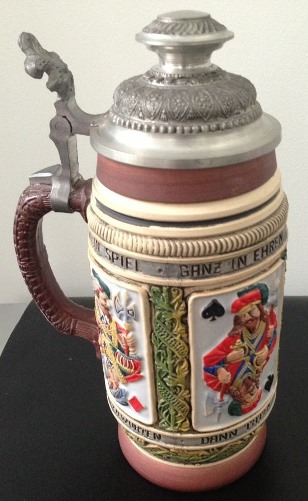 Thewalt’s entry into”who can make the brightest new card stein.” .5 liter pottery. New! A CARD GAME’S STORY: My lady and I had been teaching my daughter, Theresa, and her hubby Bill, to play pinochle for about a year off-and-on. He was transferred to the Coast Guard base in Elizabeth City, NC. So we went to see them, we got a close by hotel room and then invited them over to play.
Thewalt’s entry into”who can make the brightest new card stein.” .5 liter pottery. New! A CARD GAME’S STORY: My lady and I had been teaching my daughter, Theresa, and her hubby Bill, to play pinochle for about a year off-and-on. He was transferred to the Coast Guard base in Elizabeth City, NC. So we went to see them, we got a close by hotel room and then invited them over to play.  Theresa, my grand-daughter Caitlin, Bill and Lupin, the “Grand-dog.” (Later than the story.) Now “pinochle” is one hard card game to learn. I once calculated that in “Double Deck Pinochle” there are at least a ga-zillion combinations of the four hands that are dealt! And unlike in ‘Bridge’ the wining bidder never gets to see his mate’s cards which is only those laid on the table for meld (only the first part of the game.) Lady Julia and I had consistently beaten them playing partners for about a year while they were learning. Well this time “Lady Luck” was with them and they won and beat us badly! They were calm and composed when we said good night shortly thereafter, but for some reason (to this day I don’t know why) I opened the motel room door just after they had exited, and looked down the hallway, just in time to see them both jump up and “high five” each other! I had to laugh out-loud! Good fun!
Theresa, my grand-daughter Caitlin, Bill and Lupin, the “Grand-dog.” (Later than the story.) Now “pinochle” is one hard card game to learn. I once calculated that in “Double Deck Pinochle” there are at least a ga-zillion combinations of the four hands that are dealt! And unlike in ‘Bridge’ the wining bidder never gets to see his mate’s cards which is only those laid on the table for meld (only the first part of the game.) Lady Julia and I had consistently beaten them playing partners for about a year while they were learning. Well this time “Lady Luck” was with them and they won and beat us badly! They were calm and composed when we said good night shortly thereafter, but for some reason (to this day I don’t know why) I opened the motel room door just after they had exited, and looked down the hallway, just in time to see them both jump up and “high five” each other! I had to laugh out-loud! Good fun! 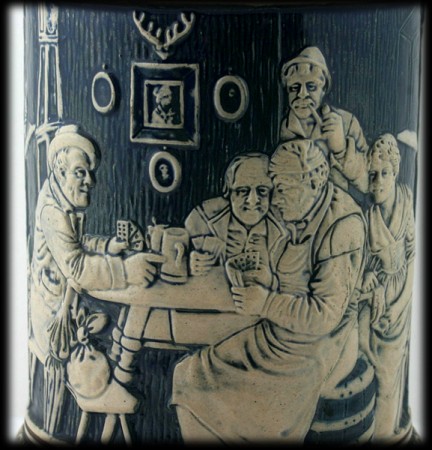 Detail of card playing scene, in relief on 1 liter pottery stein (Marzi and Remy?) shown just below.
Detail of card playing scene, in relief on 1 liter pottery stein (Marzi and Remy?) shown just below. 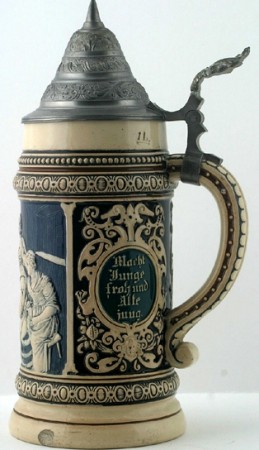 No extra charge for the chip!!
No extra charge for the chip!!
A “Go-with”, a couple of hand painted porcelain wall plaques for your home’s “Card Room.” Fantastic workmanship. I assume there was a set of four of these. And I will leave this subject of “Cards” with this one thought: 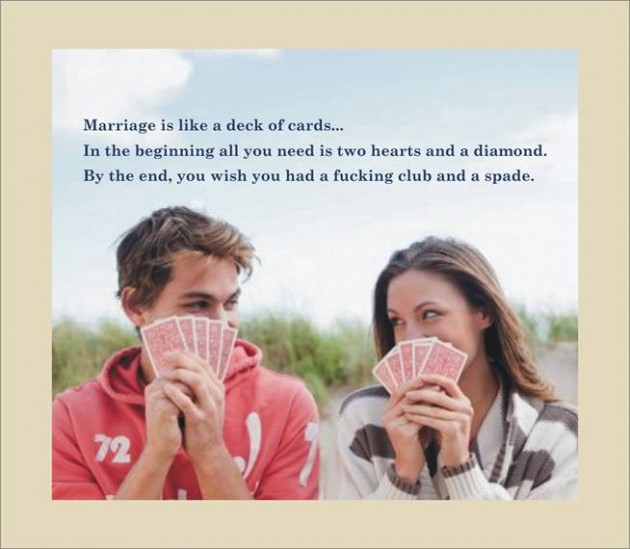 [END – SP104 – 76- R5]
[END – SP104 – 76- R5]  “When I’m finally holding all the right cards, everyone wants to play chess.”
“When I’m finally holding all the right cards, everyone wants to play chess.”


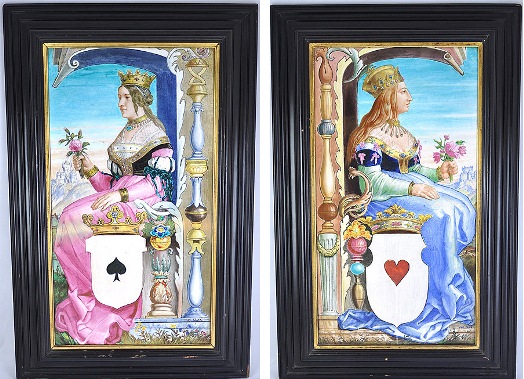
Leave a Reply